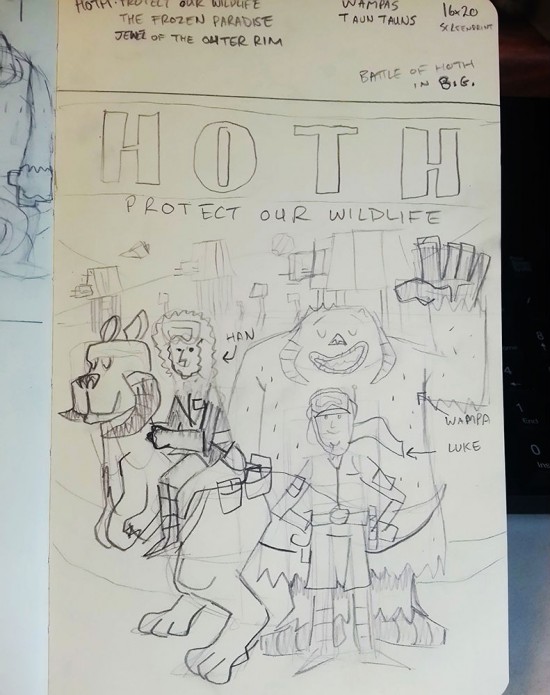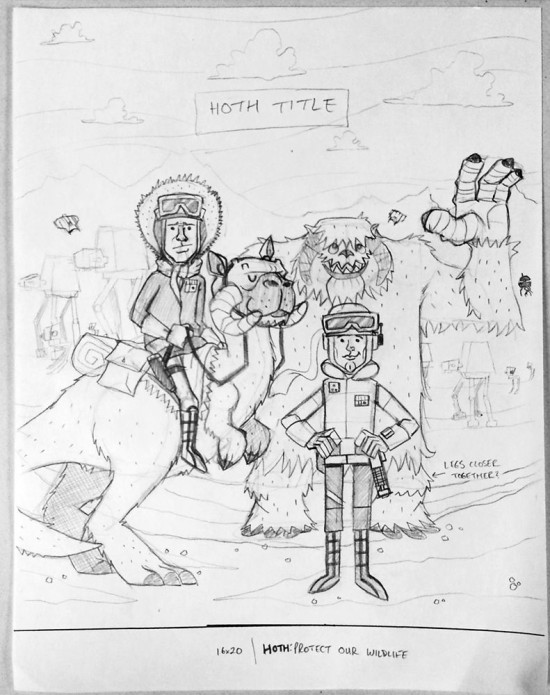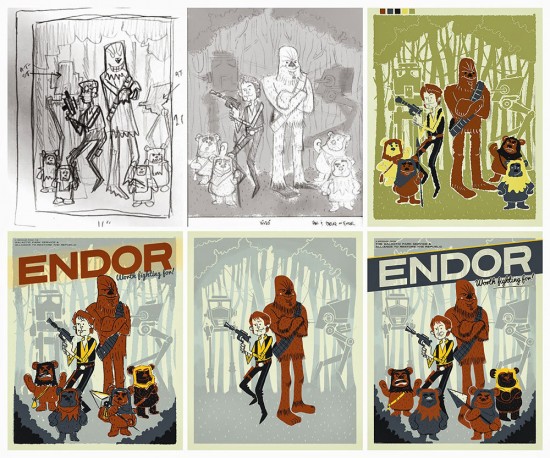Cool Stuff: Ian Glaubinger's 'Empire Strikes Back' Hoth Poster; See Early Sketches
Figuratively and literally, the Hoth location in The Empire Strikes Back is cool. It's only in the film for a few minutes, but the ice battle on Hoth has created some of our most enduring images from the entire Star Wars saga. In fact, it's so important, rumor has it J.J. Abrams is doing something similar in Star Wars Episode VII.
So if you like Hoth, how do you tell the world? Well, artist Ian Glaubinger has a suggestion. Dark Ink Art will release his latest print, Hoth: Protect Our Wildlife, at 11 a.m. PST September 26. We're happy to not only debut the piece, but show you a bunch of behind the scenes images and let Glaubinger himself explain how the poster came to be. It's a fascinating look into the creation of a seemingly simple work like this and a must read for art fans. Check out the Ian Glaubinger Hoth poster below.
If you just want to see the Ian Glaubinger Hoth poster and don't care about the making of it, here it is.

It's a 6 color silkscreen, measuring 16 x 20 inches. The edition of 150 will cost $50 and you can grab it at www.darkinkart.com.
Now, below, we have Glaubinger describing the piece in his own words, along with some cool process shots.
The piece I wanted to talk about today is my second officially licensed Star Wars piece for Acme Archives which comes out September 26. It is titled "Hoth: Protect Our Wildlife" and is the second print in the series I am calling "Galactic Park Services" or the GPS Series. The series depicts different locales with characters, creatures and vehicles unique to those specific locations (based on the Star Wars universe) all loosely based around the idea of saving wildlife, protecting environments, restoring nature, etc. After the success of my first Star Wars print I was approached by Acme Archives to do a follow-up piece in the same vein. Naturally, the only logical step was for Hoth and a wampa. The first print in the series was titled "Endor: Worth Fighting For!" and is still available (in limited quantities) for purchase from Acme Archives here.My process for this piece (along with any other licensed piece of artwork) might be similar to other artists but we each have our own unique way of approaching a new project. I can say that from my personal experience it really has been a pleasure to work with Acme Archives. First of all, getting the opportunity to work with a company like Acme Archives is a dream come true. You mean I get to draw licensed properties like Star Wars, Disney, etc. and someone will pay me? It's something I hope I never lose sight of because that is a HUGE honor, at least for me. Second, these guys are really fun (and helpful) to work with. When coming up with my print "concept" I get to bounce ideas off them and go back and forth until we hit a great idea. This is something that can be tough to do on your own but when you have experienced art directors who can help shape and tweak ideas it becomes a lot of fun.Now as far as my actual process goes, it really just starts with 2 things: Ray Stanz and a pencil. You must be thinking, how and why in the world does Ray Stanz (Dan Aykroyd from Ghostbusters) help start my work?! Well because like Ray Stanz once poetically put it, "I couldn't help it. It just popped in there. ". Meaning most of my finished work is really very close to the first thing that popped in my head. It all starts with a little thumbnail of that concept (typically this is only the size of a credit card) done with pencil and paper (seen below). This is literally the concept I send to Acme Archives for approval. They will send this concept off to the proper licensor (in this case that would be Lucas Film) and they will come back with any comments, approval or rejection for the piece concept from said licensor. In this case there were no changes or comments but that also might be due to having already done a piece for Acme/Lucas Film they knew what to expect from me as far as a finished product. I will say that when I did my first piece for them there were also no comments so I must be doing something right. Now that the concept is approved I move on to a much more fleshed out pencil drawing of the print; often on plain old 8.5"x11" white printer paper. The line work you see in this stage is often fairly close to what you'll get in the final project (seen below).
This is literally the concept I send to Acme Archives for approval. They will send this concept off to the proper licensor (in this case that would be Lucas Film) and they will come back with any comments, approval or rejection for the piece concept from said licensor. In this case there were no changes or comments but that also might be due to having already done a piece for Acme/Lucas Film they knew what to expect from me as far as a finished product. I will say that when I did my first piece for them there were also no comments so I must be doing something right. Now that the concept is approved I move on to a much more fleshed out pencil drawing of the print; often on plain old 8.5"x11" white printer paper. The line work you see in this stage is often fairly close to what you'll get in the final project (seen below). Just like the concept thumbnail, this drawing is again sent to Lucas Film (by Acme Archives) for approval and with any luck I get the "go ahead" to keep moving forward. Now at this point I just want to point out that this might not always be the case (having to send for approvals at every stage) but I am still fairly new to Acme Archives so they might want me to do this just as a means to insure everything goes smoothly. I'm sure they don't want me creating a finished piece only to send it to the licensor only to have it rejected in the end. That wouldn't be a good use of time and energy so it helps to have the official approval before moving on to the next step. In any case, the final pencil sketch was approved so on to the next step!From there I will scan in the sketch on my computer and then start to determine my color palette by loosely coloring over it. Since this print will be a screen print it will be done in a limited color palette (Why a limited color palette? Well that's a question for another day...). Once I've come up with a color palette (which includes picking the paper color too) I like which may take a couple of attempts I will send it to Acme Archives just to get their opinion or if they think it needs any changes. Below is what I call the "color comp" that I sent.
Just like the concept thumbnail, this drawing is again sent to Lucas Film (by Acme Archives) for approval and with any luck I get the "go ahead" to keep moving forward. Now at this point I just want to point out that this might not always be the case (having to send for approvals at every stage) but I am still fairly new to Acme Archives so they might want me to do this just as a means to insure everything goes smoothly. I'm sure they don't want me creating a finished piece only to send it to the licensor only to have it rejected in the end. That wouldn't be a good use of time and energy so it helps to have the official approval before moving on to the next step. In any case, the final pencil sketch was approved so on to the next step!From there I will scan in the sketch on my computer and then start to determine my color palette by loosely coloring over it. Since this print will be a screen print it will be done in a limited color palette (Why a limited color palette? Well that's a question for another day...). Once I've come up with a color palette (which includes picking the paper color too) I like which may take a couple of attempts I will send it to Acme Archives just to get their opinion or if they think it needs any changes. Below is what I call the "color comp" that I sent. Once that is approved I then move on to the final line work and coloring. All of my work on the computer is done in Adobe Photoshop with a large scale drawing tablet called a Wacom Cintiq. If you are not familiar with this device, it's like a giant super charged iPad that is a monitor that I draw directly on with a special pen. It is made specifically for illustrators to draw on the computer with and comes in a variety of models and sizes. So after all those steps of drawing and revisions and tweaks you get the final print!
Once that is approved I then move on to the final line work and coloring. All of my work on the computer is done in Adobe Photoshop with a large scale drawing tablet called a Wacom Cintiq. If you are not familiar with this device, it's like a giant super charged iPad that is a monitor that I draw directly on with a special pen. It is made specifically for illustrators to draw on the computer with and comes in a variety of models and sizes. So after all those steps of drawing and revisions and tweaks you get the final print! This is then sent to Lucasfilm for final approval before it goes to print. One fun tidbit about this piece was that before I got final approval from Lucasfilm, there was one minor revision. In my original 2 sketches I had Luke's lightsaber hanging from his belt. For whatever reason, I just completely forgot to put it in the final piece and didn't even notice. Well when Lucas Film saw the final piece, they asked why I didn't put it in the final piece and asked if it wouldn't be too much trouble to put it back in. I can't believe they noticed it and both myself and Acme missed it! Well in the end, Luke got his lightsaber and all was well in the galaxy. Well I hope you guys dug reading about how one of my pieces of art takes shape and be sure to pick up "Hoth: Protect Our Wildlife" from Acme Archives at DarkInkArt.com on September 26! I promise the print smells better then a tauntaun.One last little treat, below is my process for the first Star Wars print "Endor: Worth Fighting For!" which has a couple extra steps then my Hoth print because it was my first piece and went through a few color changes before being finalized.
This is then sent to Lucasfilm for final approval before it goes to print. One fun tidbit about this piece was that before I got final approval from Lucasfilm, there was one minor revision. In my original 2 sketches I had Luke's lightsaber hanging from his belt. For whatever reason, I just completely forgot to put it in the final piece and didn't even notice. Well when Lucas Film saw the final piece, they asked why I didn't put it in the final piece and asked if it wouldn't be too much trouble to put it back in. I can't believe they noticed it and both myself and Acme missed it! Well in the end, Luke got his lightsaber and all was well in the galaxy. Well I hope you guys dug reading about how one of my pieces of art takes shape and be sure to pick up "Hoth: Protect Our Wildlife" from Acme Archives at DarkInkArt.com on September 26! I promise the print smells better then a tauntaun.One last little treat, below is my process for the first Star Wars print "Endor: Worth Fighting For!" which has a couple extra steps then my Hoth print because it was my first piece and went through a few color changes before being finalized.
